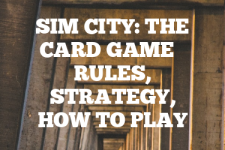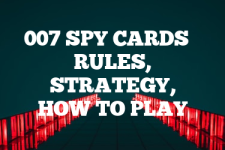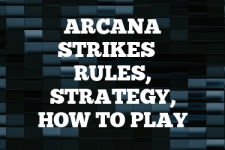A Guide to Shadowrun: The Trading Card Game – Rules, Strategy & Playing Tips
Introduction
Shadowrun: The Trading Card Game is a unique experience that combines the cyberpunk world of Shadowrun with the excitement of a collectible card game. The game was first released in the 1990s, drawing from the rich universe of the Shadowrun role-playing game. In this world, players become part of a dystopian future where magic has returned, and various fantasy races coexist with advanced technology. The game is no longer in print, but it still has a dedicated fan base that enjoys the strategic depth and the cyberpunk theme.

Quick Tip for Shadowrun: The Trading Card Game
Always keep an eye on your resources. Managing them well can be the difference between winning and losing.
Rules for playing Shadowrun: The Trading Card Game
The rules of Shadowrun: The Trading Card Game are quite detailed, but I’ll break them down for you. Each player starts with a deck of cards and a playmat that represents the game area. The goal is to complete ‘runs’ against your opponent, which involves overcoming obstacles and defeating enemy characters. Players use a mix of strategy, resource management, and a bit of luck to win.
Card Types for Shadowrun: The Trading Card Game
There are several types of cards in the game, including Runners, Sites, Upgrades, Gear, and more. Each type has a specific role. For example, Runners are your main characters who perform the runs, while Sites represent locations that can be attacked or defended. Upgrades and Gear provide enhancements to your Runners or Sites.
How to Play Shadowrun: The Trading Card Game and Game Mechanics
The game mechanics involve drawing cards, playing cards onto the playmat, and using them to interact with your opponent’s cards. The setup includes shuffling your deck and drawing an initial hand of cards. Gameplay is turn-based, with each player taking actions to play cards, attack, defend, and manage resources. The game ends when a player completes a certain number of successful runs or meets other victory conditions.
A turn in the SRTCG breaks down into six distinct phases, each occurring in the same order every turn. Here’s a breakdown of the six gameplay phases in the SRTCG:
A. Objective Phase: The Setup
- Place an Objective card face down, revealing it at the start of your next turn. Only one Objective is allowed per player at a time.
- If an Objective is removed, the player must wait until the next Objective phase to play a new one.
B. Credstick Phase: Payday
- Add 4¥ to your Credstick. Pay any upkeep costs; unable to pay, trash the card.
- Instead of collecting nuyen, draw enough cards to refill your hand to 7, but still pay any upkeep.
C. Refresh Phase: Unturn and Draw
- Unturn your controlled cards and draw one card.
- Heal Runners, Gear, and repair Gear cards with Threat Ratings.
D. Legwork Phase: Playing Your Cards
- Various options are available, paying deployment costs before using cards.
- Play Challenges, deploy or swap Runners, Contacts, or Locations, and use or play Special cards.
E. Shadowrun Phase: The Action Begins!
- Attempt one shadowrun per turn, choosing an Objective, selecting Runners, encountering Challenge Cards, and either sleazing or facing Challenges.
- If Runners succeed, they meet the Objective requirements to take it; otherwise, the Objective stays.
F. End Phase: The End of Your Turn
- Announce the end of your turn, trash excess cards if needed, and declare the turn finished.
- If the draw pile is empty, shuffle the trash pile as a new draw pile.
This comprehensive sequence guides players through the crucial actions and decisions in each phase of the game, from setting up Objectives to the critical Shadowrun phase and finally wrapping up the turn in the End phase.
Note: Effects labeled as lasting until the end of a turn refer to the conclusion of the player’s ongoing turn when the card was played.
Additionally, a condensed version of this play sequence can be found on the rules card included in each starter deck, offering a quick overview of the turn’s steps.
How to Win at Shadowrun: The Trading Card Game
To win at Shadowrun: The Trading Card Game, you need to understand both basic and advanced strategies. Beginners should focus on learning the card types and how they interact. Intermediate players can start to explore deeper strategies like deck building and resource management. Advanced players will look for ways to outmaneuver their opponents with complex plays and card combinations.
Best Strategies for playing Shadowrun: The Trading Card Game game
Shadowrun: The Trading Card Game, much like its RPG counterpart, is a complex and immersive game that combines elements of cyberpunk and fantasy. To excel at this game, players must employ strategic thinking and planning. One of the best strategies is to build a balanced deck that can handle a variety of situations. This means including a mix of spell, equipment, and character cards, allowing for both offensive and defensive plays. Players should also familiarize themselves with their cards’ synergies and combos, which can turn the tide of the game when used effectively.
Resource management is another key aspect; allocating your money and building your resources efficiently can help maintain a steady flow of actions and control the pace of the game. Moreover, adaptability is crucial, as being able to respond to an opponent’s strategy and adjust your tactics on the fly can be the difference between victory and defeat. Finally, understanding the meta-game, knowing what decks and strategies are popular, and preparing counters for them will give players an edge in competitive play. By mastering these strategies and continuously learning from each game, players can become formidable opponents in the Shadowrun universe.
The best strategies involve knowing your deck inside out and predicting your opponent’s moves. You should aim to control the pace of the game and make efficient use of your resources. Sneaky tactics might include bluffing about the strength of your hand or setting traps with hidden cards.
Deck Building and Best Cards in Shadowrun: The Trading Card Game
Building a strong deck is crucial. You’ll want a good balance of card types and a clear strategy in mind. Some of the best cards in the game are those that offer flexibility or powerful effects that can turn the tide of a game.
| Basic Deck Composition | |
|---|---|
| 12-20 Runners | 5-10 Gear cards |
| 12-20 Challenges | 1-5 Locations |
| 1-5 Contacts | 10 Specials |
Scenarios
In good scenarios, you might have a strong board presence and plenty of resources. In bad scenarios, you could be facing a powerful attack with limited defenses. The key is to stay calm and look for ways to use your cards to shift the momentum in your favor.
Frequently Asked Questions about playing Shadowrun: The Trading Card Game game
Q: How many cards can I play in a turn? A: It depends on your available resources and the specific rules of the cards you want to play.
Q: Can I change my deck between games? A: Yes, as long as it meets the deck size and composition rules.
Q: What happens if I run out of cards? A: You need to reshuffle your discard pile into a new deck, which can have strategic implications.
Additional Subtopics
Other relevant subtopics include understanding the lore of the Shadowrun universe, as it can enhance the gameplay experience. Also, participating in the community can provide opportunities to learn from other players and discover new strategies.
External Links
For more information on Shadowrun: The Trading Card Game, check out these links:
Shadowrun Fan-made Guide Website
Shadowrun: The Trading Card Game Card List

A digital native around since the early days of online gaming communities around 2001. An early contributor to the cult gaming site ClanTemplates, Adam has spent years giving free gaming resources to the community. With BoardCards, Adam is most experienced and commonly writing the articles on Strategy multi-player games like Settlers of Catan and Avalon. His first introduction to board games was via Mancala, an Egyptian-origin stone game and one of the oldest known games still played worldwide. Contact me via email



